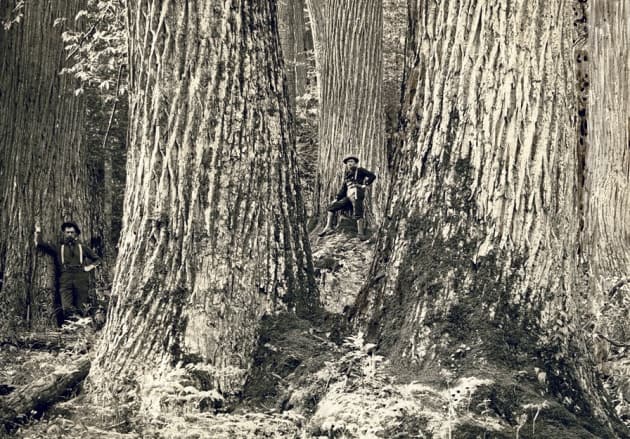
COURTESY OF THE FOREST HISTORY SOCIETY, DURHAM, NORTH CAROLINA
Received this from Faith Campbell of The Nature Conservancy. This rulemaking could have more impact on our forests than a plethora of thinning projects. Not to speak of invasives meddling with “range of natural variation”.. er.. they’re definitely “natural” but not “historic”ally in the U.S. Here’s her email…
Imports of living plants have historically been one of the most important pathways by which tree-killing insects and pathogens have entered the country. Examples of pests introduced via this pathway include chestnut blight, white pine blister rust, hemlock woolly adelgid, and sudden oak death.
On April 25th, USDA Animal and Plant Health Inspection Service published a proposed regulation [https://www.federalregister.gov/articles/2013/04/25/2013-09737/restructuring-of-regulations-on-the-importation-of-plants-for-planting] that would restructure its regulations governing imports of plants. Among the several proposed changes is language in proposed Section 319.37-21 that would establish APHIS’ authority and a framework under which plant producers overseas could be required to implement “integrated pest management measures” to ensure that plants shipped to the U.S. would be pest-free. APHIS would require use of such integrated measures when the pest risk associated with those plants could be addressed only through the use of such measures.
While the specifics of any integrated pest management measures program would be developed through negotiations by APHIS with the exporting country, the proposed overall framework would have the following components:
· Production facilities would generate plants from propagative material that is free or nearly free of pests.
· Production facilities would have an approved set of standard operating procedures that include adequate pest control, regular inspection and testing, and detailed recordkeeping of all aspects of plant production, including the origin of plants that will eventually be exported so that they may be traced back if a pest is detected by the importing country.
· The phytosanitary agency of the producing country oversees the production facility and performs regular audits to ensure that all elements of the production system comply with program standards.
· APHIS may perform on-site audits of the production system. APHIS also audits imports to ensure that these plants meet the approved standards for the clean stock program.
· Penalties and remedial action in the case of noncompliance are negotiated by APHIS and the exporting country’s phytosanitary agency.
· APHIS will require plant brokers to keep records facilitating trace-back and follow specified procedures to ensure the continued phytosanitary status of plants under their control.
The deadline for comments is June 24, 2013.
I encourage you to review the proposal and submit comments. Points you might want to make:
The proposal is one of the most important actions APHIS has taken in decades to close down the plants for planting introduction pathway. The combined actions will enable APHIS to act more quickly, even pro-actively, to minimize the risk of pest introductions. The important innovations include:
o Creating the new authority to require foreign plant suppliers to implement integrated measures (as outlined briefly above);
o Integrating the proposed new strategy with the recently finalized NAPPRA strategy,[1] under which APHIS can pre-emptively prohibit the most high-risk plant imports until effective safeguards are adopted;
o Shifting most of the specific provisions out of the regulations and into the Plants for Planting Manual should allow more rapid adaptation to changed pest situations;
o Consolidating regulatory provisions that apply to all or nearly all plant imports will improve the shipping public’s understanding an compliance.
You might also suggest that additional clarity is need re: conditions for “post-entry quarantine”. The provisions in this proposal [Proposed §319.37-23] apparently apply to only a limited number of taxa for which extensive periods in post-entry quarantine are already required. In comments on past components of this rulemaking, some of us have urged expansion of post-entry quarantine to additional taxa in order to further reduce the pest risk from a wider variety of plant and pest taxa. We called at the same time for strengthening conditions of post-entry quarantine in these expanded situations in order to ensure efficacy. Our comments were inspired in part by 2001 episode in which citrus longhorned beetles – a very large insect – escaped from bonsai trees kept in “post-entry quarantine” in a commercial nursery.